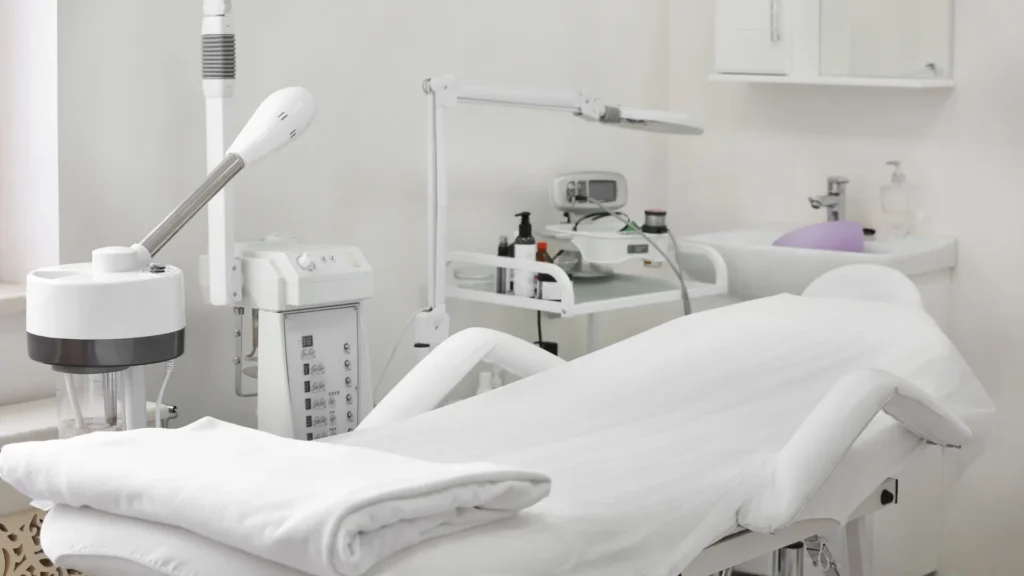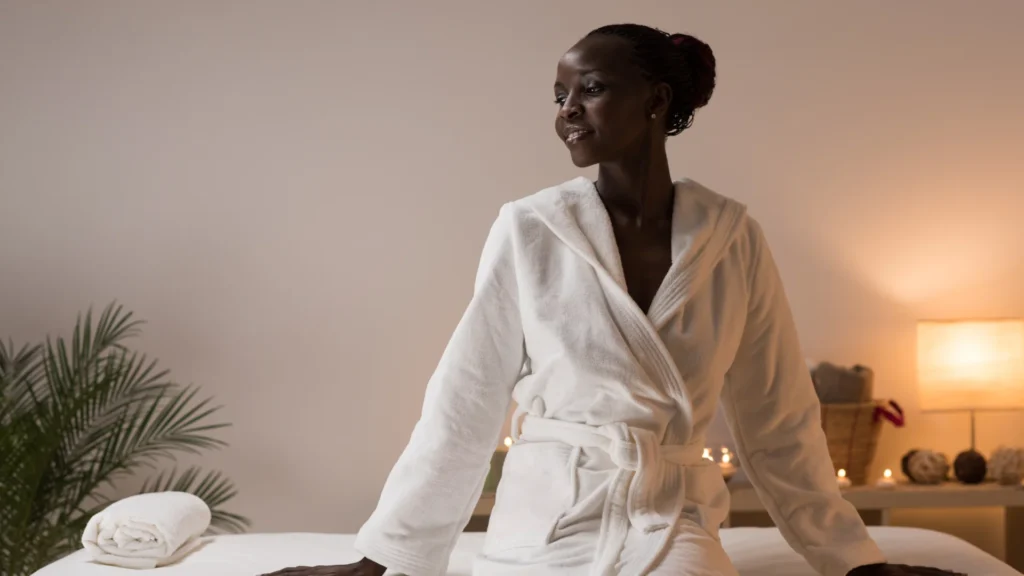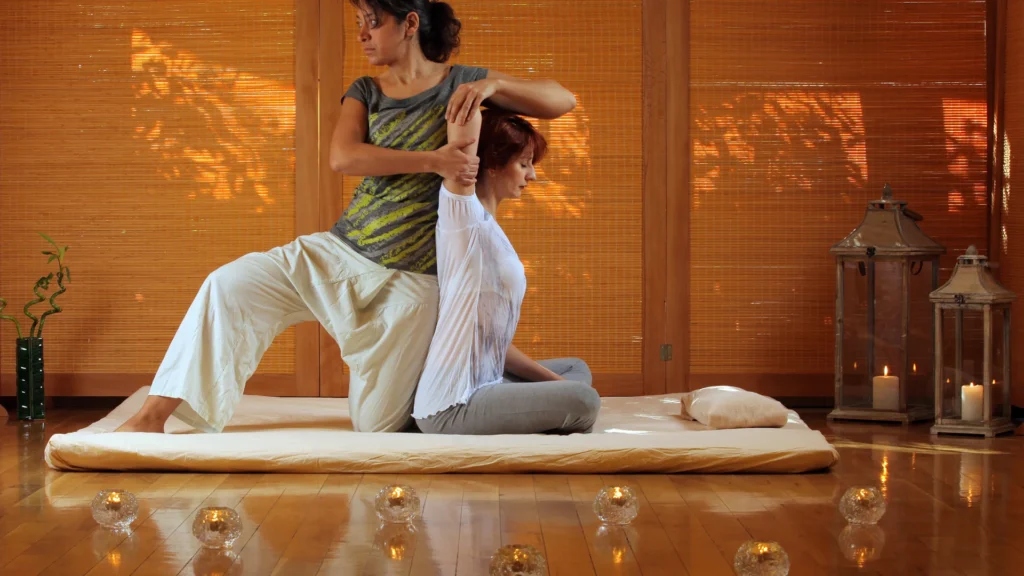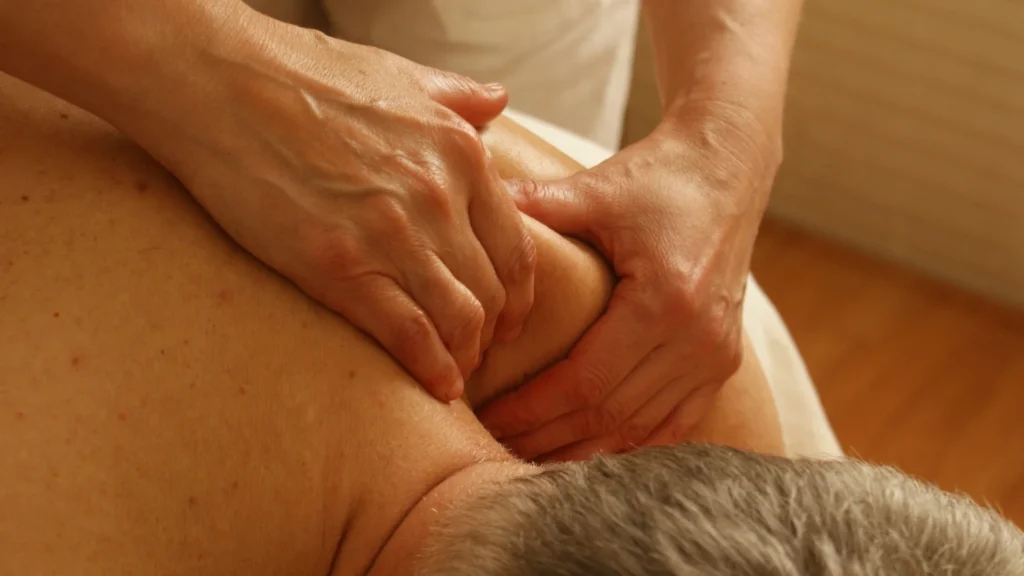In this comprehensive guide on ‘What Happens During Deep Tissue Massage Sessions and How Therapists Perform It,’ you’ll unravel:
1- The serene ambiance and setting where deep tissue magic unfolds.
2- The crucial role of initial consultations and why they’re more than just chit-chat.
3- Techniques that therapists like me employ, combined with the art of reading your body’s cues.
4- Post-massage rituals to enhance the longevity of that relaxed feeling.
Curious about what really happens during those closed-door sessions? Eager to prepare for your own deep tissue journey?
Well, you’re in for a treat. Keep reading, as this guide offers a front-row seat to the world of deep tissue massage.
Let’s dive right in and discover how!”
Jump To:
How Therapists Perform Deep Tissue Massage?
Setting the Scene
All right, picture this: you’ve made the wise decision to indulge in a deep tissue massage. As you push open the door to the massage room, a tranquil oasis awaits you. Gone is the hustle and bustle of the outside world; here, serenity takes center stage.
The room will be dimly lit, creating an atmosphere of calm. Gentle, ambient music wafts through the air, a melody that seems to slow the very beating of your heart. The massage table, dressed in soft linens, beckoned invitingly.

And wait, is that the faint aroma of lavender? Or perhaps eucalyptus? Ah, the magic of essential oils! These scents are not just a treat for the nostrils; they play a pivotal role in setting the mood and helping you relax even before the massage begins.
Now, if you’re thinking this sounds more like a cozy retreat than a therapy room, well, you’re not wrong! In my years as a therapist, I’ve learned that the environment plays a crucial role.
It’s not just about the physical touch; the ambiance is our silent partner, working in tandem with our hands to transport you to a realm of absolute relaxation. Trust me, by the time you climb onto that table, you’ll already be halfway to Cloud Nine.
NOTE: If you are a Total beginner and don’t know much about this massage, Check out my following guide: What is Mean by Deep Tissue Massage?
Initial Consultation
Now, before we set sail on this voyage of muscle relief, there’s a brief yet crucial pit stop: the initial consultation. Think of this as the compass setting for our journey. No two bodies are the same, and this chat is all about charting a course tailored just for you.
When you settle into my cozy consultation nook, I’ll have a few questions up my sleeve. “Where do you feel the tension the most?” “Any past injuries I should be aware of?” “What’s your main goal for today’s session?” Maybe you’re here for that pesky lower back pain that’s been nagging you, or perhaps it’s the stress knot in your shoulder shouting for attention. Whatever it is, this is the moment to spill the beans.

Understanding your medical history is equally vital. A sprain from five years ago or that surgery you had a while back can play a role in how we approach the massage. And fear not; all this info is tucked away under the umbrella of utmost confidentiality.
This tête-à-tête is not a one-sided affair. It’s the perfect time for you to toss any questions or concerns to your therapist. Curious about a technique? Wondering about the oils? Ask away! By the end of this chat, you’ll have a game plan in place, ensuring you get the most out of your session while feeling safe and cared for.
Preparing for the Massage
All right, with our game plan set, it’s time to prep for the main event. This might be the moment where some first-timers feel a twinge of nervousness. “What do I wear?” “How much should I undress?” Breathe easy, my friend, because here’s the scoop.
Once we’ve wrapped up our consultation, I’ll step out of the room to give you some privacy. You’ll be instructed to undress to your comfort level. Some folks opt to keep their underwear on, while others prefer to go au naturel. There’s no hard and fast rule here – it’s all about what makes you feel most at ease.
Once you’ve disrobed, you’ll slide under the soft sheets on the massage table. Called the art of draping! This technique ensures that only the part of the body I’m working on is exposed, keeping the rest snugly wrapped up.
Your modesty and comfort are top priorities. Think of it as a cocoon; you’re the caterpillar about to undergo a transformation.

And hey, if at any moment you feel too chilly or too warm, speak up! We therapists are many things, but mind-readers, we are not. A slight adjustment in room temperature or an extra blanket can make all the difference in your relaxation journey.
Now, with the stage set, the real magic is about to commence. As you nestle in, let those worries float away. This is your time. A symphony of touch and tranquility awaits!
Techniques and Movements
Alright, let’s dive into the heart of the matter: the techniques. You see, deep tissue massage is a bit like an orchestra. Each technique is an instrument, and when played together, they create a harmonious symphony of relief and relaxation.
1. Slow, Deep Strokes: We start with the basics. These strokes reach deep into your muscles, melting away the tension layer by layer. It’s like kneading dough – steady, purposeful, and deeply satisfying.
2. Friction: This isn’t your everyday friction. By applying pressure across the grain of your muscles, we help realign tissue fibers and restore flexibility. It’s a bit like untangling the knots in a necklace.
3. Stripping: Picture a long, gliding pressure along the length of your muscles, like a boat smoothly sailing on water. This technique pinpoints those pesky muscle fibers, ensuring they sing in harmony.
4. Trigger Point Therapy: Everyone’s got those little knots, or “trigger points,” that seem to hold a world of tension. With precise pressure, we coax these knots into relaxation, releasing pent-up stress.
5. Cross-Fiber Friction: Sometimes, injuries can cause our muscle fibers to become a jumbled mess. By applying pressure in a cross-fiber motion, we help realign these fibers, promoting healing and mobility.
6. PNF Stretching: Think of this as a duet between you and me. I’ll stretch a muscle group while you resist, and then you’ll relax as I stretch it further. It’s like a dance, enhancing flexibility and range of motion.
During the session, I’ll weave these techniques together, crafting a tapestry of touch that addresses your specific needs. And here’s a little insider tip: the magic lies in the combination. It’s not just about one technique; it’s about how they harmoniously work together under the skilled hands of your therapist (that’s me!).

So, as you lie there, let yourself get lost in this orchestrated dance of touch. And remember, if at any point something feels too intense or you’d like more pressure, just give me a shout. After all, this symphony is all about you.
NOTE: If you want to learn how to apply these techniques, check out my following guide: What is the Process to Apply Deep Tissue Massage Techniques?
Communication with the Therapist
Communication – it’s the secret sauce to a transformative massage experience. Now, I know some folks think they should just lie there in silence, enduring whatever comes their way, but let me let you in on a little secret: your voice is golden!
While I’ve got years under my belt and have seen more back muscles than I can count, every person’s threshold for pressure and pain is unique. What feels like a gentle press to one person might feel like a deep dive to another.
Feedback is Your Friend: If you’re thinking, “Ouch, that’s a tad too much,” don’t grit your teeth and bear it. Give me a shout! On the flip side, if you’re craving more pressure on that stubborn knot in your shoulder, let me know.
Check-ins are Key: During our session, I’ll occasionally check in with a simple “How’s the pressure?” or “Is this okay?” It’s not just chit-chat; I genuinely want to know. Your feedback guides our session.
Comfort Counts: Maybe the room’s too cold, the music’s too loud, or that pillow isn’t quite right. Whatever it is, speak up. We’re crafting an experience tailored to you, and every little detail counts.

Remember, this isn’t just my session; it’s ours. Open communication ensures that you walk out of that room feeling lighter, looser, and a whole lot more zen. So, let’s chat, share, and make this deep tissue massage the best darn experience you’ve ever had!
NOTE: If you want to try this massage at home, check out my following Guide: How to Do Deep Tissue Massage at Home? Step-by-Step Process
Adjusting Pressure
You know, there’s a common misconception floating around: “The harder the pressure, the better the massage.” But let’s debunk that myth right here, right now. Deep tissue massage isn’t about brute force; it’s about the right force. And finding that sweet spot is a blend of art and science.
Reading Your Body: As a seasoned therapist, I’ve got a knack for reading the subtle cues your body gives off. The slight tensing of muscles, a change in your breathing – these signals guide my hands. But while I rely on these cues, nothing beats good old-fashioned verbal feedback.
Intensity vs. Pain: A deep tissue massage will indeed have moments of intensity as we work to release those deep-seated knots. However, it should never cross into the realm of genuine pain. If it does, we’ve ventured too far, and it’s time to dial things back.
Customizing the Experience: Everyone has their unique “just right” level of pressure, and our goal is to find yours. Whether it’s the broad, sweeping strokes on your back or the pinpointed pressure on a stubborn knot, adjustments are made in real time, ensuring optimal results.

The beauty of a deep tissue massage lies in its adaptability. Some days, you might crave a bit more pressure, while on others, you might want something gentler. And that’s perfectly okay! After all, it’s a journey, and together, we’ll navigate it to ensure you reap all the rejuvenating benefits.
Breathing and Relaxation
Okay, let’s talk about something we all do yet often overlook: breathing. Yep, that simple act of inhaling and exhaling plays a starring role in our massage journey. Breathing is more than just getting oxygen in; it’s your personal toolkit for relaxation and pain management during a deep tissue massage.
The Magic of Deep Breaths: Have you ever noticed how a deep sigh can make you feel a smidge better when you’re stressed? There’s science behind that. Deep breaths stimulate our parasympathetic nervous system, ushering in that lovely “rest and digest” mode. During our session, when I’m diving deep into a particularly tense area, I might prompt you to take a deep breath. It’s a gentle reminder to help ease any discomfort.
Synchronized Breathing: Sometimes, I’ll sync my movements with your breath. As you inhale, I’ll ease up a bit, and as you exhale, I might delve a bit deeper. This rhythm not only aids relaxation but also makes those deeper pressures more comfortable.
Breathe Through the Intense Moments: If there’s a spot that’s particularly tender, try not to hold your breath. Instead, imagine breathing into that area, visualizing the tension melting away with each exhale. It’s a neat little trick that can work wonders!
Breathing is your anchor during the session. It keeps you grounded, helps you manage any intense moments, and enhances the overall relaxation experience. So, as we work together, let your breath flow naturally, deeply, and effortlessly. Who knew something so simple could be so powerful?
Targeting Problem Areas
Every individual brings a unique map of tension, knots, and stress points to the table, both literally and figuratively! As your therapist, it’s my mission to navigate this map, identifying and addressing these problem areas to bring you relief.
Muscle Knots & Adhesions: You know those tiny, pesky lumps you sometimes feel under your skin when you press your fingers deep into your muscles? Those are muscle knots or adhesions. They’re the culprits behind restricted movement and pain. Using targeted pressure and specific techniques, we work to break these down, restoring ease and fluidity.
Finding the Tension Points: Over the years, my hands have become finely tuned detectors, sensing areas of tension that even you might not be aware of. It’s a bit like treasure hunting, except the treasure is a relaxed, knot-free muscle!
Bespoke Treatment: While I have a repertoire of techniques at my disposal, the treatment is always tailored to you. For instance, if your shoulders are bearing the brunt of long hours at the desk, they’ll get extra attention. Or perhaps it’s your calves crying out after that marathon. They’ll be the stars of the session.
Benefits Beyond the Session: Addressing these problem areas does more than just provide immediate relief. It enhances circulation, promotes better posture, and can significantly improve your range of motion.
So, while you might come in thinking you just have that one troublesome spot, you’ll leave with a holistic sense of relief. It’s all about connecting the dots, ensuring each area gets the love and attention it deserves, and paving the way for holistic well-being. And That’s What happens in deep tissue Massage sessions.
Post-Massage Care and Recommendations
Once our symphony of touch and relief wraps up and you’re basking in that post-massage glow, you might wonder, “What now?” Well, the journey doesn’t quite end when you step off the table. Here’s how to make the most of that newfound sense of relaxation and ensure the benefits linger on.
The Afterglow Might Have a Hint of Soreness: It’s not uncommon to feel a tad sore post-session, especially if it’s your first deep tissue massage. It’s akin to the sensation after a rigorous workout. But worry not; this typically fades in a day or two.
Stay Hydrated: Imagine your muscles as sponges that we’ve just wrung out. Now, it’s time to replenish them. Drinking water helps flush out any toxins released during the massage and keeps your muscles hydrated and supple.
Gentle Movement and Stretching: A leisurely walk or some gentle stretches can help maintain that lovely sense of flexibility and ease post-massage. But do listen to your body – if it’s asking for rest, grant it that luxury.
Warmth is Your Friend: A warm bath with Epsom salts can be heavenly after a massage. The warmth soothes any lingering soreness, and the salts further relax your muscles.
Mind Your Posture: Now that your muscles are all nice and relaxed, it’s an excellent time to be mindful of your posture, whether you’re sitting, standing, or walking. Good posture can help maintain the benefits of the massage and prevent new tensions from forming.
Listen to Your Body: If a particular area feels especially tender, give it some TLC. Maybe an ice pack or a warm compress, depending on what feels right.

And lastly, don’t rush back into the hustle and bustle. If you can, carve out some quiet time post-massage to bask in the relaxation. Maybe a little meditation, some soft music, or just a peaceful nap.
Remember, a deep tissue massage is a gift to your body. And with a tad bit of post-session care, you can extend that gift, ensuring you feel rejuvenated for days to come!
Duration and Frequency
“How long does a typical deep tissue massage last? And how often should I indulge?” These are two of the most common queries I encounter!
Let’s dive into the nitty-gritty of timing and frequency.
Session Duration:
1. 60 Minutes: Often dubbed the “golden standard,” a one-hour session provides ample time to address general tension areas and offers a holistic massage experience. Perfect for those looking to unwind and de-stress.
2. 90 Minutes: If you’ve got specific problem areas or chronic tension, an extended 90-minute session might be your best bet. It allows for more targeted work while still ensuring a full-body massage.
Frequency – How Often Should You Visit?
1. Initial Intensive Phase: If you’re addressing specific issues or chronic pain, I usually recommend starting with more frequent sessions – perhaps once a week. This intensive phase helps kick-start the healing process.
2. Maintenance Phase: Once you’ve achieved your initial goals, you can transition to a maintenance phase. Here, monthly sessions (or every six weeks) can be ideal, ensuring you keep those pesky tensions at bay.
3. Pure Relaxation: If you’re seeking massages primarily for relaxation and general well-being, a monthly session might be just the ticket.
Of course, these are general guidelines. Every individual is unique, and your optimal duration and frequency might vary based on your goals, lifestyle, and, of course, how your body feels. After our initial sessions, I’ll be better equipped to guide you on a tailored plan, ensuring your deep tissue massage journey aligns perfectly with your needs.
Final Thoughts on What Happens During Deep Tissue Massage Sessions
That brings us to the end of this guide on how therapists perform Deep Tissue Massage. From setting the serene scene to understanding the intricacies of techniques, we’ve covered it all together. But let’s take a moment to circle back to the heart of it all.
Deep tissue massage isn’t just about applying pressure or working out knots. It’s a harmonious dance between the therapist and the client, where communication, trust, and expertise come together to create a transformative experience. As your guide on this journey, my mission is to ensure you not only understand the process but truly relish every moment.
For those of you considering taking the plunge into the world of deep tissue massage, I hope this insider’s peek has armed you with the knowledge and confidence to take that step. Remember, this is a journey tailored to you, and each session is an opportunity to reconnect with yourself, to heal, and to rejuvenate.






